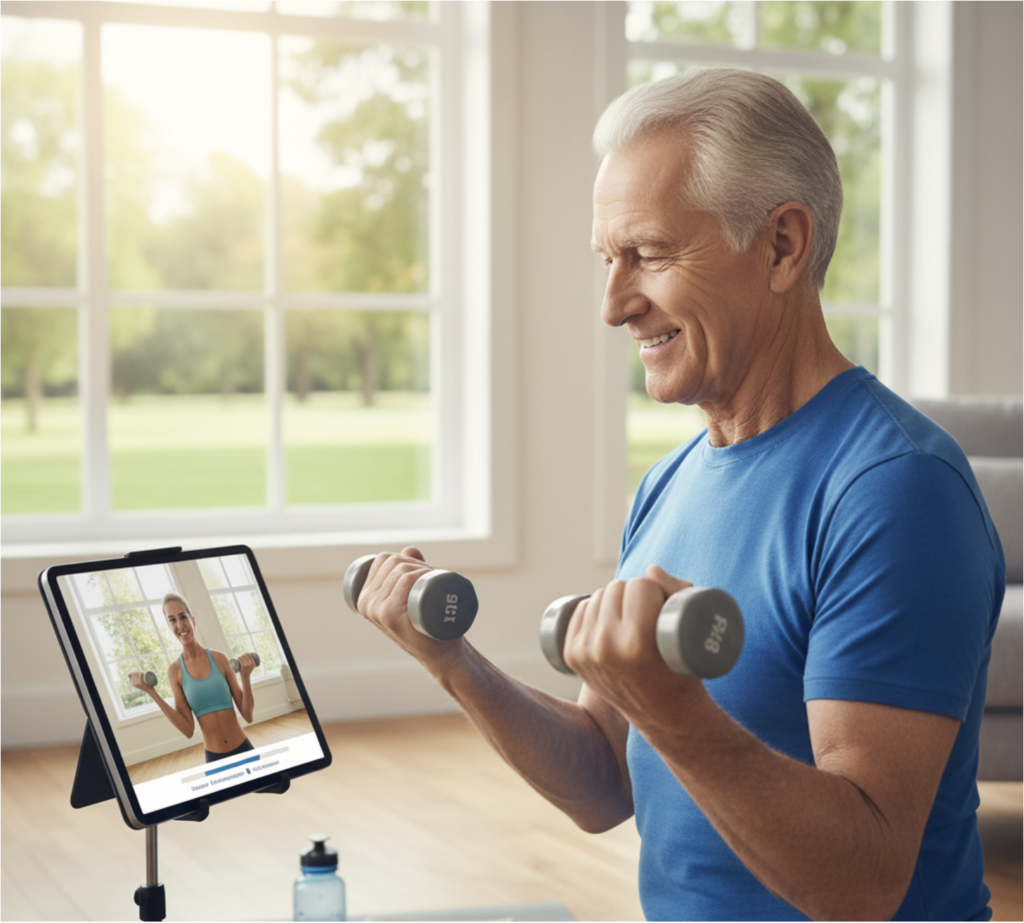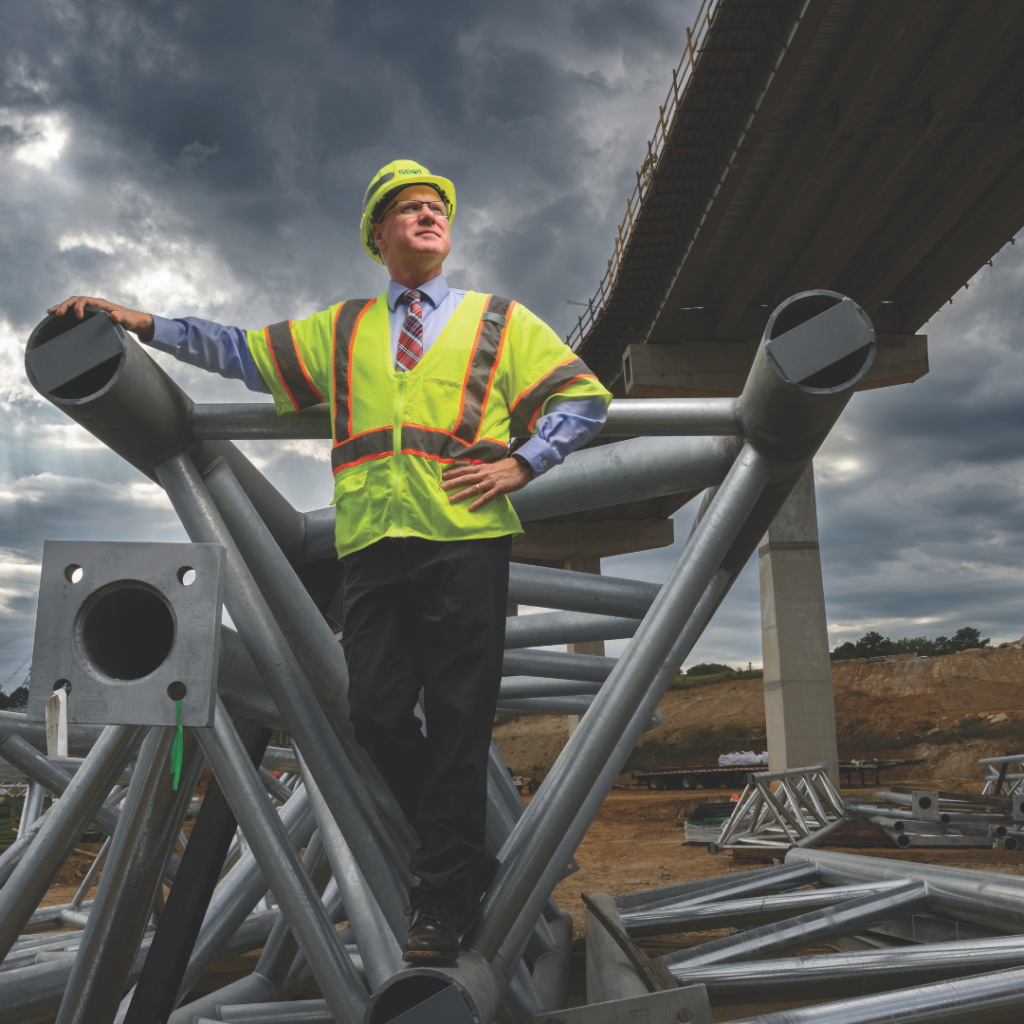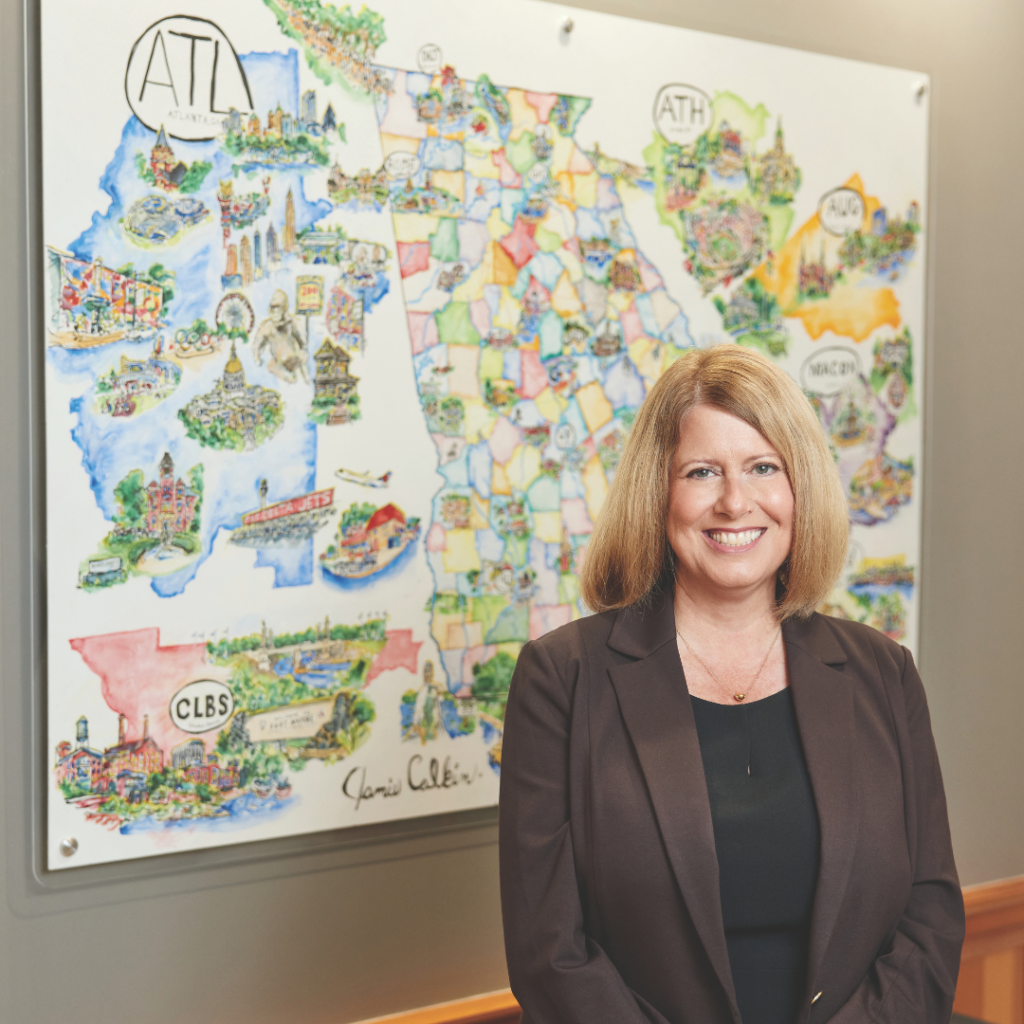When the Heart Stops Working
Sudden cardiac arrest is often deadly, even to young athletes, but some preventative measure can save lives.
Dublin, Georgia teenager Lexi Lowman may be the last person you would think would be at risk for heart disease. A year ago, at just 18, the high school senior and former competitive cheerleader was preparing to add a job as a patient care tech to her accomplishments and busy schedule. As a dual-enrollment student, she was just four months away from receiving both her associate degree and high school diploma.

A Community Response: Dr. Robert Whitehill, pediatric cardiologist at Children’s Healthcare of Atlanta and medical director of Project SAVE, photo Ben Rollins.
But on January 10, 2023, the unthinkable happened. As the teen arrived to begin her second day of orientation at Fairview Park Hospital in Dublin she collapsed from sudden cardiac arrest, a condition where the heart suddenly stops beating.
Although she remembers little about that day and the week or so that followed, she learned from those who were there that her sister, a nurse practitioner at the hospital, performed mouth-to-mouth resuscitation. And an astute office manager and nurse started CPR and administered a shock with an automated external defibrillator (AED) that restored her heart rhythm. While she doesn’t remember being rushed to Fairview Park’s emergency room, being life-flighted to Piedmont Hospital in Atlanta or being placed on a ventilator, she does have vague memories of her first days at Piedmont, when doctors talked about organ failure and possible amputation of her right leg due to lack of blood flow.
It’s Not a Heart Attack
Even though heart disease is the No. 1 killer of both men and women worldwide, it is shocking when heart disease threatens the life of a young person like Lowman. But experts in heart health say raising awareness about the specific risks to teens and young adults could save lives.
When most people think of death from heart disease, they think of a heart attack, or, in medical terms, myocardial infarction, says Dr. Robert Whitehill, a pediatric cardiologist with Children’s Healthcare of Atlanta.

Know Your Numbers: Dr. Glen Henry, medical director of interventional cardiology and the cardiac catheterization labs at Georgia Heart Institute, photo Northeast Georgia Health System.
Heart attacks occur almost exclusively in adults, mostly in people who are middle aged or older. While cardiac arrest can occur because the heart is damaged during a heart attack – and having a heart attack does make sudden cardiac arrest more likely – the two are not the same.
“A heart attack and cardiac arrest are two very distinct things,” says Whitehill. He describes a heart attack as a plumbing problem – blockage in one of the coronary arteries severely reduces or blocks blood flow to the heart. Sudden cardiac arrest, on the other hand, is primarily an electrical problem in which the heart’s failure to do its job causes a person to pass out and stop breathing.
“[When] the heart muscle is not effective [at] pumping blood due to some abnormal heart rhythm … that can lead to cardiac arrest [as] your brain is not getting enough oxygen,” he says.
According to the CDC, more than 356,000 people have an out-of-hospital cardiac arrest in the United States every year. While the incidence of cardiac arrest, like heart attack, goes up as we get older, cardiac arrest can happen at any age. The incidence appears to increase at adolescence and continues to rise throughout adulthood. And although it’s rare, it can occur even in young athletes, as evidenced by two recent high-profile cases. In January 2023, 24-year-old Buffalo Bills football player Damar Hamlin collapsed on the field after making a tackle in a game against the Cincinnati Bengals. And in July, 18-year-old college basketball player Bronny James, son of NBA star LeBron James, collapsed during basketball practice at the University of Southern California.
Both Hamlin and James survived, thanks to immediate medical attention on the field and the basketball court. But the majority of people who experience cardiac arrest each year, including about 2,000 seemingly healthy people under age 25, do not.
Causes and Questions
Coronary artery disease – where plaque builds up in the arteries – is the No. 1 cause of out-of-hospital cardiac arrest for the population as a whole, says Dr. Glen Henry, medical director of interventional cardiology and the cardiac catheterization labs at Georgia Heart Institute in Gainesville. Adopting heart-heathy habits early on may prevent cardiac arrests related to coronary artery disease down the line.
Henry recommends that people of all ages know their numbers – “what your glucose [blood sugar] is, and if you have diabetes, what your A1C is,” he says. “Know what your blood pressure is, what your cholesterol is and what your weight is. All of these numbers are associated with [your] risk of heart and vascular disease.” People should know their numbers at a young age because problems take time to build up, he says. “…The time for intervention is when people are younger.”
When cardiac arrest happens in young people, it’s often due to an existing but undiagnosed condition such as:
- Hypertrophic cardiomyopathy, an inherited condition where muscle cells in the heart ventricles thicken. It can cause an abnormal heart rhythm, particularly during exercise.
- Genetic conditions that affect the heart’s electrical impulses.
- Defects in coronary arteries that limit blood flow to the heart.
- An abnormal heart rhythm called commotio cordis, caused by a hard blow to the chest – by a baseball, hockey puck or collision with another player, for example. Commotio cardis caused Damar Hamlin’s cardiac arrest.
- Myocarditis, or inflammation of the heart muscle. It can sometimes be caused by a viral infection like COVID.
Lowman’s cardiac arrest was due to myocarditis, likely caused by a cold she had a month earlier. “I remember having a cold back in December, but you don’t think anything of that. You take over-the-counter medicines and you’re fine,” she says.
But in many cases – as many as 40% to 50%, in fact – the cause of cardiac arrest in young people is unknown, Whitehill says. “Even with all of the best testing, we can’t always get an answer to why something happens, and that is a number that we need to make much smaller, but that is unfortunately the reality.”
Warning Signs – Or Not
Lowman says she didn’t feel quite right a few days before her cardiac arrest. She had chest pain, nausea and fatigue, which she attributed to the stress of school and work.
“What I tell my patients is it can happen on the best day of your life. Everything is going fine and it’s like somebody reaching for the light switch and flipping the light down and your light goes out.” Dr. Robert Sorrentino.

Dr. Rober Sorrentino, Creel Distinguished Chair in Cardiology, Augusta University, photo contributed.
Most times, however, cardiac arrest happens without warning. “What I tell my patients is it can happen on the best day of your life. Everything is going fine and it’s like somebody reaching for the light switch and flipping the light down and your light goes out,” says Dr. Robert Sorrentino, who holds the Creel Distinguished Chair in Cardiology at Augusta University.
For a young person a sudden cardiac arrest may be the first – and final – sign of a problem. But sometimes there are warnings to identify people who may be at risk. The American Academy of Pediatrics recommends asking these four questions:
- Have you ever fainted, passed out or had a seizure suddenly and without warning, especially during exercise or in response to auditory triggers such as doorbells, alarm clocks and ringing telephones?
- Have you ever had exercise-induced chest pain or shortness of breath?
- Are you related to anyone with sudden, unexplained and unexpected death before the age of 50?
- Are you related to anyone who has been diagnosed with a sudden death-predisposing heart condition?
Children and teens with any of these risk factors may be referred to a cardiologist to see if they need tests or treatment.
That treatment could consist of drugs to control the heart’s rhythm, surgery to fix structural abnormalities or placement of an implantable cardioverter-defibrillator (ICD) or a battery-operated device that is able to detect a dangerous change in heart rhythm and send an electrical shock to the heart to correct it.
ICDs can also protect survivors of cardiac arrest like Lowman from experiencing a second one.
Prevention Requires Preparedness
In an effort to prevent cardiac arrest in healthy young people, a Georgia law requires all students to have a sports physical before competing in a school sport. But physicals have limitations, says Sorrentino. “That is usually going to a family doctor to ask questions about how you feel, how are you doing,” he says. “They check your blood pressure. They listen to your heart and lungs. But that is very superficial, so things still happen.”
Some experts, school districts and parent groups have proposed mandating echocardiograms, which would pick up on structural abnormalities in the heart. But there are still problems that echocardiograms would not reveal, and requiring them for healthy young people is expensive, impractical and raises additional questions, Sorrentino says.
“If you try to do that and screen populations of folks, are you going to make everybody who plays high school sports get an echocardiogram before they participate? Who is going to pay the bill?” he asks. “So then you say you are going to do it for high school, but what about kids that play football, competitive sports or gymnastics, and they start at a much younger age? Where do you draw the line?”
Even in the best of circumstances, doctors can’t recognize everyone at risk before something happens. “We can’t identify everybody. Events are going to happen in our communities, so what we can we do as a community to respond?” says Whitehill.
Two Georgia-based programs – CARES (which stands for the Cardiac Arrest Registry to Enhance Survival) and Project SAVE (Sudden cardiac arrest, Awareness, Vision for prevention, Education) – are addressing that question.

Lifesaver: Thanks to Project Save, students at St. Pius X Catholic High School learn CPR and how to use an AED. Pictured are student-athlete Olivia Pajer, left, and Children’s Healthcare of Atlanta athletic trainer Laschanda Pituk, right, photo Ben Rollins.
Founded by Emory University and the CDC in 2004, the CARES registry was created to give EMS agencies and providers the information they need to improve efforts to revive people who experience cardiac arrest, says Tiara Sinkfield, director of state programs for CARES.
People can survive cardiac arrest, but there’s a sequence of events that must take place: a call to 911, CPR, use of an AED, a rapid EMS response and prompt treatment at the hospital. Basically, Sinkfield says, CARES helps identify where there is a breakdown in that chain of events, so EMS providers can know whether their efforts in the field are actually working and if bystanders are giving CPR. The system will show any weaknesses, she says. “They are able to use the information they get from the registry to hopefully implement [change] in their communities.”
CARES is a national organization with 33 statewide registries as well as 51 additional participating communities in 14 different states, including Georgia, that altogether include 2,300 EMS agencies and over 2,500 hospitals. The CDC recently awarded CARES a $23.85 million, five-year grant to update its software and expand into all 50 states.
Project SAVE was started by Children’s Heart Center with the mission of preventing sudden cardiac arrest in children, teens and young adults in Georgia communities, by educating and training people to handle a cardiac arrest. Since 2004, Project SAVE has saved more than 125 lives.
“Through Project SAVE we are supporters of getting AEDs into every school, in every gym. We would love it if they were in every dance studio, house of worship or place where people are congregating and they are active,” says Whitehill, who is medical director of Project SAVE. “But it’s not enough to have an AED – we want to make sure there is a team of people who are qualified to use it.”
To build such teams, Project SAVE works with communities and schools including Atlanta’s St. Pius X Catholic High School where, thanks to one student’s concern and action, all freshmen must learn CPR and how to use an AED as part of their health and wellness class.
Olivia Pajer, a 17-year-old member of the volleyball, swim and dive, and track and field teams at St. Pius X, was watching an episode of Real Sports with Bryant Gumbel on HBO when she became concerned about the risk of cardiac arrest. “It was talking about sudden cardiac arrest in young athletes, and one of the clips was a volleyball player, and that kind of related to me because I play volleyball, and yes, this can happen to me,” she says. Fortunately for the athlete in the video, her team had an emergency action plan and knew what to do in the situation, Pajer recalls. But a young basketball player in another clip was not as fortunate. “He went into cardiac arrest, and his coach told his teammates to get an AED. His two teammates had no idea what it looked like, no idea what it was and by the time they figured out where it was, it was too late.”
Although Pajer knew there were a number of AEDs on campus, she wondered if any of her teammates would know where to find them or how to use them if she, another player or a coach collapsed. With the agreement and support of her school’s dean of academics, Pajer contacted SAVE, which trained and certified two of St. Pius’ health and wellness teachers to teach CPR and AED use to students. Training in CPR and AED use became part of the health and wellness curriculum for all freshmen this winter, Pajer says.
Henry believes training young people could be the best defense against sudden cardiac death. “We talk about the importance of being part of society, and we have all of these great school systems, and … if everyone graduated high school and knew how to do [basic CPR], imagine what a great army of people that would be out there able to help someone out in time of catastrophe,” he says.
A Story of Caution – And Hope
A year after the incident that almost took her life, Lowman is a full-time employee at Fairview Park Hospital, working overnight shifts while she makes plans and saves for nursing school. Her goal is to earn her doctorate degree and become a nurse practitioner, possibly in cardiology.
Because of the prompt action of those around her, Lowman’s story has a happy ending. With measures like education about how cardiac arrest can affect teens and young adults – even athletes – and the widespread availability of AEDs, there is a growing chance that stories of many other Georgians will end happily, as well.






